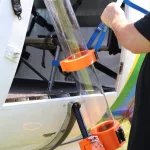Staff from the Kaua‘i Forest Bird Recovery Project (KFBRP) heralded last Thursday’s first release of male mosquitoes, into a state forest reserve on the vast Alakaʻi Plateau, as momentous.
Ten years of planning, permitting and community outreach led the team and its partners, to the release of male mosquitoes that are reproductively incompatible with female mosquitoes, which bite and spread the often-deadly disease.
IIT has been deployed successfully around the world, mostly to combat human malaria. This is the first time it’s been used on Kaua‘i as a biological control to try and severely reduce the number of malaria-carrying mosquitoes.
The mosquitoes are flown from a facility in California and each week, half a million bugs will be loaded onto a helicopter in biodegradable cones that resemble an ice cream sugar cone.
The deployment helicopters are outfitted with a specially designed tube which directs each cone out of the bottom of the aircraft, where they float to the ground.
The bird recovery teams are employing what experts call “integrated pest management.” In addition to the IIT releases, they’re using a common larvicide known as BTi, which targets one phase of the mosquito life cycle – the larval phase. It’s been used on the ground on the Alakaʻi for nine years, and over the past year it’s also been applied from helicopters. IIT targets the adult stage and the egg production stage.
The insurance they have for the continued existence of the most critically endangered birds, are conservation breeding populations.
DLNR Photo
